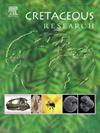New discoveries of lepidosteoid scales from the Upper Cretaceous in Songliao Basin, China
IF 1.7
3区 地球科学
Q1 GEOLOGY
引用次数: 0
Abstract
This study explores the morphological and histological characteristics of isolated rhomboid scales recovered from the Late Cretaceous Nenjiang Formation in Northeast China. Six distinct scale morphotypes were identified and compared with scales of various Holostei taxa. Macroscopic observations reveal that most scale exhibit small or completely absent peg-and-socket articulations and lack of tubercles and denticles. Histologically, these scales display lepidosteoid-type ganoid scale characteristics: a multi-layered enameloid layer forms the ganoine covering, which overlies the isopedine layer. The isopedine layer is densely penetrated by numerous Williamson’s canals and contains abundant well-developed osteocyte lacunae. Although these isolated scale fossils resemble primitive Holostei scales, they cannot be confidently assigned to any known neopterygian taxa. The detailed morphological and histological analyses of these isolated Cretaceous scale fossils provide more precise data, advancing our understanding of Mesozoic fish diversity and evolutionary trends in the Songliao Basin.
松辽盆地上白垩统鳞片新发现
研究了中国东北晚白垩世嫩江组分离菱形鳞片的形态和组织学特征。鉴定出6种不同的鳞片形态,并与不同全骨虫分类群的鳞片进行了比较。宏观观察显示,大多数鳞片表现为小或完全缺失钉窝关节,缺乏结节和小齿。组织学上,这些鳞片表现出鳞片骨性类瘤鳞片的特征:多层的类瘤质层形成了盖在异哌啶层上的瘤氨酸覆盖物。异哌啶层被大量的威廉姆森管密集渗透,并含有大量发育良好的骨细胞腔隙。虽然这些孤立的鳞片化石类似于原始的全骨虫鳞片,但它们不能被自信地归属于任何已知的新翼龙分类群。这些白垩纪鳞片化石的详细形态和组织学分析为松辽盆地中生代鱼类多样性和进化趋势的认识提供了更精确的数据。
本文章由计算机程序翻译,如有差异,请以英文原文为准。
求助全文
约1分钟内获得全文
求助全文
来源期刊

Cretaceous Research
地学-地质学
CiteScore
4.10
自引率
19.00%
发文量
235
审稿时长
12 weeks
期刊介绍:
Cretaceous Research provides a forum for the rapid publication of research on all aspects of the Cretaceous Period, including its boundaries with the Jurassic and Palaeogene. Authoritative papers reporting detailed investigations of Cretaceous stratigraphy and palaeontology, studies of regional geology, and reviews of recently published books are complemented by short communications of significant new findings.
Papers submitted to Cretaceous Research should place the research in a broad context, with emphasis placed towards our better understanding of the Cretaceous, that are therefore of interest to the diverse, international readership of the journal. Full length papers that focus solely on a local theme or area will not be accepted for publication; authors of short communications are encouraged to discuss how their findings are of relevance to the Cretaceous on a broad scale.
Research Areas include:
• Regional geology
• Stratigraphy and palaeontology
• Palaeobiology
• Palaeobiogeography
• Palaeoceanography
• Palaeoclimatology
• Evolutionary Palaeoecology
• Geochronology
• Global events.
 求助内容:
求助内容: 应助结果提醒方式:
应助结果提醒方式:


